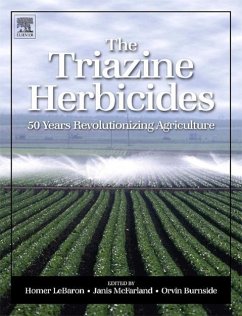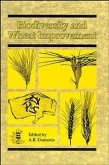Homer M. LeBaron (ed.-in-chief)
The Triazine Herbicides
Herausgeber: MC Farland Ph D, Janis; Burnside Ph D, Orvin
Homer M. LeBaron (ed.-in-chief)
The Triazine Herbicides
Herausgeber: MC Farland Ph D, Janis; Burnside Ph D, Orvin
- Gebundenes Buch
- Merkliste
- Auf die Merkliste
- Bewerten Bewerten
- Teilen
- Produkt teilen
- Produkterinnerung
- Produkterinnerung
Over the past 50 years, triazines have made a great impact on agriculture and world hunger by assisting in the development of new farming methods, providing greater farming and land use capabilities, and increasing crop yields. Triazines are registered in over 80 countries and save billions of dollars a year. The Triazine Herbicides is the one book that presents a comprehensive view of the total science and agriculture of these chemicals. With emphasis on how the chemicals are studied and developed, reviewed, and used at the agricultural level this book provides valuable insight into the benefits of triazine herbicides for sustainable agriculture.…mehr
Andere Kunden interessierten sich auch für
![Biodiversity and Wheat Improvement Biodiversity and Wheat Improvement]() Biodiversity and Wheat Improvement770,99 €
Biodiversity and Wheat Improvement770,99 €![Food Security in the Developing World Food Security in the Developing World]() Food Security in the Developing World160,99 €
Food Security in the Developing World160,99 €![In the Bubble In the Bubble]() John ThackaraIn the Bubble31,99 €
John ThackaraIn the Bubble31,99 €![The Foundations of Expected Utility The Foundations of Expected Utility]() P.C. FishburnThe Foundations of Expected Utility153,99 €
P.C. FishburnThe Foundations of Expected Utility153,99 €![Nanomaterials for Thermoelectric Devices Nanomaterials for Thermoelectric Devices]() Nanomaterials for Thermoelectric Devices155,99 €
Nanomaterials for Thermoelectric Devices155,99 €![The Use of Economic Statistics The Use of Economic Statistics]() Conrad BlythThe Use of Economic Statistics180,99 €
Conrad BlythThe Use of Economic Statistics180,99 €![Unmanned Aircraft Systems Unmanned Aircraft Systems]() Unmanned Aircraft Systems214,99 €
Unmanned Aircraft Systems214,99 €-
-
-
Over the past 50 years, triazines have made a great impact on agriculture and world hunger by assisting in the development of new farming methods, providing greater farming and land use capabilities, and increasing crop yields. Triazines are registered in over 80 countries and save billions of dollars a year. The Triazine Herbicides is the one book that presents a comprehensive view of the total science and agriculture of these chemicals. With emphasis on how the chemicals are studied and developed, reviewed, and used at the agricultural level this book provides valuable insight into the benefits of triazine herbicides for sustainable agriculture.
Hinweis: Dieser Artikel kann nur an eine deutsche Lieferadresse ausgeliefert werden.
Hinweis: Dieser Artikel kann nur an eine deutsche Lieferadresse ausgeliefert werden.
Produktdetails
- Produktdetails
- Verlag: Elsevier Science
- Seitenzahl: 600
- Erscheinungstermin: 25. März 2008
- Englisch
- Abmessung: 286mm x 227mm x 41mm
- Gewicht: 1710g
- ISBN-13: 9780444511676
- ISBN-10: 0444511679
- Artikelnr.: 21762713
- Herstellerkennzeichnung
- Libri GmbH
- Europaallee 1
- 36244 Bad Hersfeld
- gpsr@libri.de
- Verlag: Elsevier Science
- Seitenzahl: 600
- Erscheinungstermin: 25. März 2008
- Englisch
- Abmessung: 286mm x 227mm x 41mm
- Gewicht: 1710g
- ISBN-13: 9780444511676
- ISBN-10: 0444511679
- Artikelnr.: 21762713
- Herstellerkennzeichnung
- Libri GmbH
- Europaallee 1
- 36244 Bad Hersfeld
- gpsr@libri.de
Homer M. LeBaron was born May13, 1926 in southern Alberta, Canada, the third in a family of 10 children, growing up on a diversified irrigation farm. He obtained a B.S. degree in 1955 and M.S. in 1957 from Utah State University, and in 1960 received a Ph.D. degree from Cornell University. From 1960 to 1964, Dr. LeBaron was employed as a plant physiologist at the Virginia Tech Experiment Station in Norfolk, Virginia.
From 1964 to 1991, Dr. LeBaron was employed by Geigy Chemical Corporation and CIBA-GEIGY (later Novartis, now Syngenta). For the latter nine years he was Senior Research Fellow in Biochemistry and New Technology and Basic Research Departments, where he had the responsibility for coordinating and directing outside basic research on all CIBA-GEIGY agricultural products.
Dr. LeBaron has been a member of the International Weed Science society, Weed Science Society of America (WSSA), American Society of Agronomy, American Chemical Society, Entomological Society of America, American Phytopathological Society, Council for Agricultural Science and Technology (CAST), Sigma Xi, Aquatic Plant Management Society, European Weed Research Society, and about 10 other regional, national or international scientific societies.
Homer has held numerous leadership positions, including being on the Board of Directors of several of these scientific societies. He served as president of the Northeastern Weed Science Society (NEWSS) in 1969-70, of the Southern Weed Science Society (SWSS) in 1986-87, and of WSSA in 1989-90; the only scientist to have served as president of three weed science societies.
In 1961 Dr. LeBaron received the Best Scientific Paper Award at the NEWSS; in 1978 was elected a Fellow in the WSSA, in 1988 received the Distinguished Service Award in the SWSS, and a USDA Certificate of Appreciation in 1990 for outstanding leadership in groundwater research programs. In February 1991 he became the fifth agricultural scientist (first from industry) to receive the Charles A. Black Award from CAST in recognition of his years of contributions in promoting sound science and public understanding of agriculture.
Dr. LeBaron is the author or co-author of about 90 scientific publications and was an editor and/or author of six books or special reports, including: (1) Herbicide Resistance in Plants, by John Wiley and Sons, 1982, (2) The Resistance of Agricultural Pests to Control Measures, CAST Report No. 97, 1983, (3) Pesticide ResistanceStrategies and Tactics for Management, by the National Academy of Science, Board on Agriculture, 1986, (4) Biotechnology in Agricultural Chemistry, by the American Chemical Society (ACS Symposium Series #334, 1987), (5) Managing Resistance to AgrochemicalsFrom Fundamental Research to Practical Strategies, (ACS Symposium Series #421, 1990) and (6) Ecological Impacts of Federal Conservation and Cropland Reduction Programs, CAST Report #117, 1990. He served on the parent Herbicide Resistance Action Committee (HRAC) under GIFAP, as well as a member of the ALS/AHAS Inhibitors Resistance Working Group, and as Chairman of the Triazine Resistance Working Group. Until retirement he served on the Executive and Planning Committees and Co-Chair of the Weed Resistance Management Working Group within the International Organization for Resistant Pest Management (IORPM), which organized a worldwide congress held in 1992. Dr. LeBaron was on the program committee for the International Crop Science Congress held at Iowa State University, July 14-22, 1992.
Since retirement Homer has consulted on agricultural, environmental and pest management issues for CIBA-GEIGY (Syngenta), DuPont and others. He is presently senior editor and author of several chapters in a book titled, The Triazine Herbicides, completed in 2007 and to be published soon. He recently served on the Utah State University College of Agriculture Alumni Council, and was president of the Council in 1997-98. He also served on the National Advisory Board for Brigham Young University College of Biology and Agriculture from 1995-2000.
From 1964 to 1991, Dr. LeBaron was employed by Geigy Chemical Corporation and CIBA-GEIGY (later Novartis, now Syngenta). For the latter nine years he was Senior Research Fellow in Biochemistry and New Technology and Basic Research Departments, where he had the responsibility for coordinating and directing outside basic research on all CIBA-GEIGY agricultural products.
Dr. LeBaron has been a member of the International Weed Science society, Weed Science Society of America (WSSA), American Society of Agronomy, American Chemical Society, Entomological Society of America, American Phytopathological Society, Council for Agricultural Science and Technology (CAST), Sigma Xi, Aquatic Plant Management Society, European Weed Research Society, and about 10 other regional, national or international scientific societies.
Homer has held numerous leadership positions, including being on the Board of Directors of several of these scientific societies. He served as president of the Northeastern Weed Science Society (NEWSS) in 1969-70, of the Southern Weed Science Society (SWSS) in 1986-87, and of WSSA in 1989-90; the only scientist to have served as president of three weed science societies.
In 1961 Dr. LeBaron received the Best Scientific Paper Award at the NEWSS; in 1978 was elected a Fellow in the WSSA, in 1988 received the Distinguished Service Award in the SWSS, and a USDA Certificate of Appreciation in 1990 for outstanding leadership in groundwater research programs. In February 1991 he became the fifth agricultural scientist (first from industry) to receive the Charles A. Black Award from CAST in recognition of his years of contributions in promoting sound science and public understanding of agriculture.
Dr. LeBaron is the author or co-author of about 90 scientific publications and was an editor and/or author of six books or special reports, including: (1) Herbicide Resistance in Plants, by John Wiley and Sons, 1982, (2) The Resistance of Agricultural Pests to Control Measures, CAST Report No. 97, 1983, (3) Pesticide ResistanceStrategies and Tactics for Management, by the National Academy of Science, Board on Agriculture, 1986, (4) Biotechnology in Agricultural Chemistry, by the American Chemical Society (ACS Symposium Series #334, 1987), (5) Managing Resistance to AgrochemicalsFrom Fundamental Research to Practical Strategies, (ACS Symposium Series #421, 1990) and (6) Ecological Impacts of Federal Conservation and Cropland Reduction Programs, CAST Report #117, 1990. He served on the parent Herbicide Resistance Action Committee (HRAC) under GIFAP, as well as a member of the ALS/AHAS Inhibitors Resistance Working Group, and as Chairman of the Triazine Resistance Working Group. Until retirement he served on the Executive and Planning Committees and Co-Chair of the Weed Resistance Management Working Group within the International Organization for Resistant Pest Management (IORPM), which organized a worldwide congress held in 1992. Dr. LeBaron was on the program committee for the International Crop Science Congress held at Iowa State University, July 14-22, 1992.
Since retirement Homer has consulted on agricultural, environmental and pest management issues for CIBA-GEIGY (Syngenta), DuPont and others. He is presently senior editor and author of several chapters in a book titled, The Triazine Herbicides, completed in 2007 and to be published soon. He recently served on the Utah State University College of Agriculture Alumni Council, and was president of the Council in 1997-98. He also served on the National Advisory Board for Brigham Young University College of Biology and Agriculture from 1995-2000.
Foreword - Dennis T. Avery
Chapter 1 - The Triazine Herbicides: A Milestone in the Development of
Modern Crop Technology - Homer M. LeBaron and Janis McFarland
Chapter 2 - History of the Discovery and Development of Triazine Herbicides
- Gustav Müller
Chapter 3 - Registration and Production of Triazine Herbicides - Walter
Heri, Franz Pfister, Beth Carroll, Thomas Parshley, and James B. Nabors
Chapter 4 - Weed Control Trends and Practices in North America - David R.
Pike, Ellery L. Knake, and Marshal D. McGlamery
Chapter 5 - Farming Trends and Practices in Northern Europe - James H.
Orson
Chapter 6 - Biology and Ecology of Weeds and the Impact of Triazine
Herbicides - Homer M. LeBaron and Gustav Müller
Chapter 7 - Plant Uptake and Metabolism of Triazine Herbicides - Bruce J.
Simoneaux and Thomas J. Gould
Chapter 8 - The Mode of Action of Triazine Herbicides in Plants - Achim
Trebst
Chapter 9 - Basis of Crop Selectivity and Weed Resistance to Triazine
Herbicides - Amit Shukla and Malcolm D. Devine
Chapter 10 - Distribution and Management of Triazine-Resistant Weeds -
Homer M. LeBaron
Chapter 11 - Weeds Resistant to Nontriazine Classes of Herbicides - Homer
M. LeBaron and Eugene R. Hill
Chapter 12 - The Use of Economic Benefit Models in Estimating the Value of
Triazine Herbicides - Gerald A. Carlson
Chapter 13 - Benefits of Triazine Herbicides in Corn and Sorghum Production
- David C. Bridges
Chapter 14 - Benefits of Triazine Herbicides in Ecofallow - David L. Regehr
and Charles A. Norwood
Chapter 15 - Weed Control in Sugarcane and the Role of Triazine Herbicides
- Dudley T. Smith, Edward P. Richard, Jr., and Lance T. Santo
Chapter 16 - Benefits of Triazine Herbicides and Other Weed Control
Technology in Citrus Management - Megh Singh and Shiv D. Sharma
Chapter 17 - Benefits of Triazine Herbicides for Weed Control in Fruit and
Nut Crops - Clyde L. Elmore and Arthur H. Lange
Chapter 18 - Benefits of Triazine Herbicides in the Production of
Ornamentals and Conifer Trees - John F. Ahrens and Michael Newton
Chapter 19 - Benefits of Triazine Herbicides in Turf - G. Euel Coats, Steve
T. Kelly, and James M. Taylor
Chapter 20 - Methods of Analysis for Triazine Herbicides and Their
Metabolites - Richard A. McLaughlin, Michael V. Barringer, James F. Brady,
and Robert A. Yokley
Chapter 21 - Triazine Soil Interactions - David A. Laird and William C.
Koskinen
Chapter 22 - Microbial Degradation of s Triazine Herbicides - Raphi T.
Mandelbaum, Michael J. Sadowsky and Lawrence P. Wackett
Chapter 23 - Nonbiological Degradation of Triazine Herbicides: Photolysis
and Hydrolysis - Allan J. Cessna
Chapter 24 - Soil Movement and Persistence of Triazine Herbicides - William
C. Koskinen and Philip Banks
Chapter 25 - Hazard Assessment for Selected Symmetrical and Asymmetrical
Triazine Herbicides - Charles B. Breckenridge, Christoph Werner, James T.
Stevens, and Darrell D. Sumner
Chapter 26 - Mode of Action of Atrazine for Mammary Tumor Formation in the
Female Sprague-Dawley Rats - Lawrence T. Wetzel and J. Charles Eldridge
Chapter 27 - Dietary Exposure Assessment of the Triazine Herbicides -
Leslie D. Bray, Nina Heard, Robert A. Kahrs, Arpad Z. Szarka, and Dennis S.
Hackett
Chapter 28 - Probabilistic Assessment of Laboratory-Derived Acute Toxicity
Data for the Triazine Herbicides to Aquatic Organisms - Keith R. Solomon
and Dennis Cooper
Chapter 29 - Atrazine and Simazine Monitoring Data in Community Water
Systems in the United States During 1993 to 2000 - Dennis P. Tierney, B. R.
Christensen, Cheryl Dando and Kendra M. Marut
Chapter 30 - A Decade of Measuring, Monitoring, and Studying the Fate and
Transport of Triazine Herbicides in Groundwater, Surface Water, Reservoirs,
and Precipitation by the U.S. Geological Survey - E. Michael Thurman and
Elisabeth A. Scribner
Chapter 31 - Probabilistic Risk Assessment Using Atrazine and Simazine as a
Model - Robert L. Sielken, Jr., Robert S. Bretzlaff and Cirisco
Valdez-Flores
Chapter 32 - Progress in Best Management Practices - John F. Hebblethwaite
and Carol N. Somody
Chapter 33 - Environmental Benefits of Triazine Use in Conservation Tillage
- Richard S. Fawcett
Chapter 34 - Role of Triazine Herbicides in Sustainable Agriculture:
Potential of Nonchemical Weed Control Methods as Substitutes for Herbicides
in United States Corn Production - Leonard P. Gianessi and Janet E.
Carpenter
Chapter 35 - Environmental Stewardship: The Roots of a Family Farm - Jere
White
Appendix Table 1 - Chemical structures, names and weights of triazine
herbicides
Appendix Table 2 - Physical/chemical properties of triazine herbicides
Appendix Table 3 - Selected metabolites of various triazine herbicides
listed by metabolic processes or by individual compound
Appendix Table 4A - Scientific and common names of weeds mentioned in this
book in alphabetic order by scientific name
Appendix Table 4B - Common and scientific names of weeds mentioned in this
book in alphabetic order by common name
Appendix Table 5 - Triazine herbicide use as percent crop treated in major
US crops during 2002
Chapter 1 - The Triazine Herbicides: A Milestone in the Development of
Modern Crop Technology - Homer M. LeBaron and Janis McFarland
Chapter 2 - History of the Discovery and Development of Triazine Herbicides
- Gustav Müller
Chapter 3 - Registration and Production of Triazine Herbicides - Walter
Heri, Franz Pfister, Beth Carroll, Thomas Parshley, and James B. Nabors
Chapter 4 - Weed Control Trends and Practices in North America - David R.
Pike, Ellery L. Knake, and Marshal D. McGlamery
Chapter 5 - Farming Trends and Practices in Northern Europe - James H.
Orson
Chapter 6 - Biology and Ecology of Weeds and the Impact of Triazine
Herbicides - Homer M. LeBaron and Gustav Müller
Chapter 7 - Plant Uptake and Metabolism of Triazine Herbicides - Bruce J.
Simoneaux and Thomas J. Gould
Chapter 8 - The Mode of Action of Triazine Herbicides in Plants - Achim
Trebst
Chapter 9 - Basis of Crop Selectivity and Weed Resistance to Triazine
Herbicides - Amit Shukla and Malcolm D. Devine
Chapter 10 - Distribution and Management of Triazine-Resistant Weeds -
Homer M. LeBaron
Chapter 11 - Weeds Resistant to Nontriazine Classes of Herbicides - Homer
M. LeBaron and Eugene R. Hill
Chapter 12 - The Use of Economic Benefit Models in Estimating the Value of
Triazine Herbicides - Gerald A. Carlson
Chapter 13 - Benefits of Triazine Herbicides in Corn and Sorghum Production
- David C. Bridges
Chapter 14 - Benefits of Triazine Herbicides in Ecofallow - David L. Regehr
and Charles A. Norwood
Chapter 15 - Weed Control in Sugarcane and the Role of Triazine Herbicides
- Dudley T. Smith, Edward P. Richard, Jr., and Lance T. Santo
Chapter 16 - Benefits of Triazine Herbicides and Other Weed Control
Technology in Citrus Management - Megh Singh and Shiv D. Sharma
Chapter 17 - Benefits of Triazine Herbicides for Weed Control in Fruit and
Nut Crops - Clyde L. Elmore and Arthur H. Lange
Chapter 18 - Benefits of Triazine Herbicides in the Production of
Ornamentals and Conifer Trees - John F. Ahrens and Michael Newton
Chapter 19 - Benefits of Triazine Herbicides in Turf - G. Euel Coats, Steve
T. Kelly, and James M. Taylor
Chapter 20 - Methods of Analysis for Triazine Herbicides and Their
Metabolites - Richard A. McLaughlin, Michael V. Barringer, James F. Brady,
and Robert A. Yokley
Chapter 21 - Triazine Soil Interactions - David A. Laird and William C.
Koskinen
Chapter 22 - Microbial Degradation of s Triazine Herbicides - Raphi T.
Mandelbaum, Michael J. Sadowsky and Lawrence P. Wackett
Chapter 23 - Nonbiological Degradation of Triazine Herbicides: Photolysis
and Hydrolysis - Allan J. Cessna
Chapter 24 - Soil Movement and Persistence of Triazine Herbicides - William
C. Koskinen and Philip Banks
Chapter 25 - Hazard Assessment for Selected Symmetrical and Asymmetrical
Triazine Herbicides - Charles B. Breckenridge, Christoph Werner, James T.
Stevens, and Darrell D. Sumner
Chapter 26 - Mode of Action of Atrazine for Mammary Tumor Formation in the
Female Sprague-Dawley Rats - Lawrence T. Wetzel and J. Charles Eldridge
Chapter 27 - Dietary Exposure Assessment of the Triazine Herbicides -
Leslie D. Bray, Nina Heard, Robert A. Kahrs, Arpad Z. Szarka, and Dennis S.
Hackett
Chapter 28 - Probabilistic Assessment of Laboratory-Derived Acute Toxicity
Data for the Triazine Herbicides to Aquatic Organisms - Keith R. Solomon
and Dennis Cooper
Chapter 29 - Atrazine and Simazine Monitoring Data in Community Water
Systems in the United States During 1993 to 2000 - Dennis P. Tierney, B. R.
Christensen, Cheryl Dando and Kendra M. Marut
Chapter 30 - A Decade of Measuring, Monitoring, and Studying the Fate and
Transport of Triazine Herbicides in Groundwater, Surface Water, Reservoirs,
and Precipitation by the U.S. Geological Survey - E. Michael Thurman and
Elisabeth A. Scribner
Chapter 31 - Probabilistic Risk Assessment Using Atrazine and Simazine as a
Model - Robert L. Sielken, Jr., Robert S. Bretzlaff and Cirisco
Valdez-Flores
Chapter 32 - Progress in Best Management Practices - John F. Hebblethwaite
and Carol N. Somody
Chapter 33 - Environmental Benefits of Triazine Use in Conservation Tillage
- Richard S. Fawcett
Chapter 34 - Role of Triazine Herbicides in Sustainable Agriculture:
Potential of Nonchemical Weed Control Methods as Substitutes for Herbicides
in United States Corn Production - Leonard P. Gianessi and Janet E.
Carpenter
Chapter 35 - Environmental Stewardship: The Roots of a Family Farm - Jere
White
Appendix Table 1 - Chemical structures, names and weights of triazine
herbicides
Appendix Table 2 - Physical/chemical properties of triazine herbicides
Appendix Table 3 - Selected metabolites of various triazine herbicides
listed by metabolic processes or by individual compound
Appendix Table 4A - Scientific and common names of weeds mentioned in this
book in alphabetic order by scientific name
Appendix Table 4B - Common and scientific names of weeds mentioned in this
book in alphabetic order by common name
Appendix Table 5 - Triazine herbicide use as percent crop treated in major
US crops during 2002
Foreword - Dennis T. Avery
Chapter 1 - The Triazine Herbicides: A Milestone in the Development of
Modern Crop Technology - Homer M. LeBaron and Janis McFarland
Chapter 2 - History of the Discovery and Development of Triazine Herbicides
- Gustav Müller
Chapter 3 - Registration and Production of Triazine Herbicides - Walter
Heri, Franz Pfister, Beth Carroll, Thomas Parshley, and James B. Nabors
Chapter 4 - Weed Control Trends and Practices in North America - David R.
Pike, Ellery L. Knake, and Marshal D. McGlamery
Chapter 5 - Farming Trends and Practices in Northern Europe - James H.
Orson
Chapter 6 - Biology and Ecology of Weeds and the Impact of Triazine
Herbicides - Homer M. LeBaron and Gustav Müller
Chapter 7 - Plant Uptake and Metabolism of Triazine Herbicides - Bruce J.
Simoneaux and Thomas J. Gould
Chapter 8 - The Mode of Action of Triazine Herbicides in Plants - Achim
Trebst
Chapter 9 - Basis of Crop Selectivity and Weed Resistance to Triazine
Herbicides - Amit Shukla and Malcolm D. Devine
Chapter 10 - Distribution and Management of Triazine-Resistant Weeds -
Homer M. LeBaron
Chapter 11 - Weeds Resistant to Nontriazine Classes of Herbicides - Homer
M. LeBaron and Eugene R. Hill
Chapter 12 - The Use of Economic Benefit Models in Estimating the Value of
Triazine Herbicides - Gerald A. Carlson
Chapter 13 - Benefits of Triazine Herbicides in Corn and Sorghum Production
- David C. Bridges
Chapter 14 - Benefits of Triazine Herbicides in Ecofallow - David L. Regehr
and Charles A. Norwood
Chapter 15 - Weed Control in Sugarcane and the Role of Triazine Herbicides
- Dudley T. Smith, Edward P. Richard, Jr., and Lance T. Santo
Chapter 16 - Benefits of Triazine Herbicides and Other Weed Control
Technology in Citrus Management - Megh Singh and Shiv D. Sharma
Chapter 17 - Benefits of Triazine Herbicides for Weed Control in Fruit and
Nut Crops - Clyde L. Elmore and Arthur H. Lange
Chapter 18 - Benefits of Triazine Herbicides in the Production of
Ornamentals and Conifer Trees - John F. Ahrens and Michael Newton
Chapter 19 - Benefits of Triazine Herbicides in Turf - G. Euel Coats, Steve
T. Kelly, and James M. Taylor
Chapter 20 - Methods of Analysis for Triazine Herbicides and Their
Metabolites - Richard A. McLaughlin, Michael V. Barringer, James F. Brady,
and Robert A. Yokley
Chapter 21 - Triazine Soil Interactions - David A. Laird and William C.
Koskinen
Chapter 22 - Microbial Degradation of s Triazine Herbicides - Raphi T.
Mandelbaum, Michael J. Sadowsky and Lawrence P. Wackett
Chapter 23 - Nonbiological Degradation of Triazine Herbicides: Photolysis
and Hydrolysis - Allan J. Cessna
Chapter 24 - Soil Movement and Persistence of Triazine Herbicides - William
C. Koskinen and Philip Banks
Chapter 25 - Hazard Assessment for Selected Symmetrical and Asymmetrical
Triazine Herbicides - Charles B. Breckenridge, Christoph Werner, James T.
Stevens, and Darrell D. Sumner
Chapter 26 - Mode of Action of Atrazine for Mammary Tumor Formation in the
Female Sprague-Dawley Rats - Lawrence T. Wetzel and J. Charles Eldridge
Chapter 27 - Dietary Exposure Assessment of the Triazine Herbicides -
Leslie D. Bray, Nina Heard, Robert A. Kahrs, Arpad Z. Szarka, and Dennis S.
Hackett
Chapter 28 - Probabilistic Assessment of Laboratory-Derived Acute Toxicity
Data for the Triazine Herbicides to Aquatic Organisms - Keith R. Solomon
and Dennis Cooper
Chapter 29 - Atrazine and Simazine Monitoring Data in Community Water
Systems in the United States During 1993 to 2000 - Dennis P. Tierney, B. R.
Christensen, Cheryl Dando and Kendra M. Marut
Chapter 30 - A Decade of Measuring, Monitoring, and Studying the Fate and
Transport of Triazine Herbicides in Groundwater, Surface Water, Reservoirs,
and Precipitation by the U.S. Geological Survey - E. Michael Thurman and
Elisabeth A. Scribner
Chapter 31 - Probabilistic Risk Assessment Using Atrazine and Simazine as a
Model - Robert L. Sielken, Jr., Robert S. Bretzlaff and Cirisco
Valdez-Flores
Chapter 32 - Progress in Best Management Practices - John F. Hebblethwaite
and Carol N. Somody
Chapter 33 - Environmental Benefits of Triazine Use in Conservation Tillage
- Richard S. Fawcett
Chapter 34 - Role of Triazine Herbicides in Sustainable Agriculture:
Potential of Nonchemical Weed Control Methods as Substitutes for Herbicides
in United States Corn Production - Leonard P. Gianessi and Janet E.
Carpenter
Chapter 35 - Environmental Stewardship: The Roots of a Family Farm - Jere
White
Appendix Table 1 - Chemical structures, names and weights of triazine
herbicides
Appendix Table 2 - Physical/chemical properties of triazine herbicides
Appendix Table 3 - Selected metabolites of various triazine herbicides
listed by metabolic processes or by individual compound
Appendix Table 4A - Scientific and common names of weeds mentioned in this
book in alphabetic order by scientific name
Appendix Table 4B - Common and scientific names of weeds mentioned in this
book in alphabetic order by common name
Appendix Table 5 - Triazine herbicide use as percent crop treated in major
US crops during 2002
Chapter 1 - The Triazine Herbicides: A Milestone in the Development of
Modern Crop Technology - Homer M. LeBaron and Janis McFarland
Chapter 2 - History of the Discovery and Development of Triazine Herbicides
- Gustav Müller
Chapter 3 - Registration and Production of Triazine Herbicides - Walter
Heri, Franz Pfister, Beth Carroll, Thomas Parshley, and James B. Nabors
Chapter 4 - Weed Control Trends and Practices in North America - David R.
Pike, Ellery L. Knake, and Marshal D. McGlamery
Chapter 5 - Farming Trends and Practices in Northern Europe - James H.
Orson
Chapter 6 - Biology and Ecology of Weeds and the Impact of Triazine
Herbicides - Homer M. LeBaron and Gustav Müller
Chapter 7 - Plant Uptake and Metabolism of Triazine Herbicides - Bruce J.
Simoneaux and Thomas J. Gould
Chapter 8 - The Mode of Action of Triazine Herbicides in Plants - Achim
Trebst
Chapter 9 - Basis of Crop Selectivity and Weed Resistance to Triazine
Herbicides - Amit Shukla and Malcolm D. Devine
Chapter 10 - Distribution and Management of Triazine-Resistant Weeds -
Homer M. LeBaron
Chapter 11 - Weeds Resistant to Nontriazine Classes of Herbicides - Homer
M. LeBaron and Eugene R. Hill
Chapter 12 - The Use of Economic Benefit Models in Estimating the Value of
Triazine Herbicides - Gerald A. Carlson
Chapter 13 - Benefits of Triazine Herbicides in Corn and Sorghum Production
- David C. Bridges
Chapter 14 - Benefits of Triazine Herbicides in Ecofallow - David L. Regehr
and Charles A. Norwood
Chapter 15 - Weed Control in Sugarcane and the Role of Triazine Herbicides
- Dudley T. Smith, Edward P. Richard, Jr., and Lance T. Santo
Chapter 16 - Benefits of Triazine Herbicides and Other Weed Control
Technology in Citrus Management - Megh Singh and Shiv D. Sharma
Chapter 17 - Benefits of Triazine Herbicides for Weed Control in Fruit and
Nut Crops - Clyde L. Elmore and Arthur H. Lange
Chapter 18 - Benefits of Triazine Herbicides in the Production of
Ornamentals and Conifer Trees - John F. Ahrens and Michael Newton
Chapter 19 - Benefits of Triazine Herbicides in Turf - G. Euel Coats, Steve
T. Kelly, and James M. Taylor
Chapter 20 - Methods of Analysis for Triazine Herbicides and Their
Metabolites - Richard A. McLaughlin, Michael V. Barringer, James F. Brady,
and Robert A. Yokley
Chapter 21 - Triazine Soil Interactions - David A. Laird and William C.
Koskinen
Chapter 22 - Microbial Degradation of s Triazine Herbicides - Raphi T.
Mandelbaum, Michael J. Sadowsky and Lawrence P. Wackett
Chapter 23 - Nonbiological Degradation of Triazine Herbicides: Photolysis
and Hydrolysis - Allan J. Cessna
Chapter 24 - Soil Movement and Persistence of Triazine Herbicides - William
C. Koskinen and Philip Banks
Chapter 25 - Hazard Assessment for Selected Symmetrical and Asymmetrical
Triazine Herbicides - Charles B. Breckenridge, Christoph Werner, James T.
Stevens, and Darrell D. Sumner
Chapter 26 - Mode of Action of Atrazine for Mammary Tumor Formation in the
Female Sprague-Dawley Rats - Lawrence T. Wetzel and J. Charles Eldridge
Chapter 27 - Dietary Exposure Assessment of the Triazine Herbicides -
Leslie D. Bray, Nina Heard, Robert A. Kahrs, Arpad Z. Szarka, and Dennis S.
Hackett
Chapter 28 - Probabilistic Assessment of Laboratory-Derived Acute Toxicity
Data for the Triazine Herbicides to Aquatic Organisms - Keith R. Solomon
and Dennis Cooper
Chapter 29 - Atrazine and Simazine Monitoring Data in Community Water
Systems in the United States During 1993 to 2000 - Dennis P. Tierney, B. R.
Christensen, Cheryl Dando and Kendra M. Marut
Chapter 30 - A Decade of Measuring, Monitoring, and Studying the Fate and
Transport of Triazine Herbicides in Groundwater, Surface Water, Reservoirs,
and Precipitation by the U.S. Geological Survey - E. Michael Thurman and
Elisabeth A. Scribner
Chapter 31 - Probabilistic Risk Assessment Using Atrazine and Simazine as a
Model - Robert L. Sielken, Jr., Robert S. Bretzlaff and Cirisco
Valdez-Flores
Chapter 32 - Progress in Best Management Practices - John F. Hebblethwaite
and Carol N. Somody
Chapter 33 - Environmental Benefits of Triazine Use in Conservation Tillage
- Richard S. Fawcett
Chapter 34 - Role of Triazine Herbicides in Sustainable Agriculture:
Potential of Nonchemical Weed Control Methods as Substitutes for Herbicides
in United States Corn Production - Leonard P. Gianessi and Janet E.
Carpenter
Chapter 35 - Environmental Stewardship: The Roots of a Family Farm - Jere
White
Appendix Table 1 - Chemical structures, names and weights of triazine
herbicides
Appendix Table 2 - Physical/chemical properties of triazine herbicides
Appendix Table 3 - Selected metabolites of various triazine herbicides
listed by metabolic processes or by individual compound
Appendix Table 4A - Scientific and common names of weeds mentioned in this
book in alphabetic order by scientific name
Appendix Table 4B - Common and scientific names of weeds mentioned in this
book in alphabetic order by common name
Appendix Table 5 - Triazine herbicide use as percent crop treated in major
US crops during 2002








